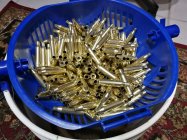Im working up a load to check velocity for 6.5 creedmoor and as I'm seating the bullet I notice that sometimes the bullet glides in smooth and sometimes it feels like there is more resistance.
During brass prep I check the inner neck diameter and they are very consistent, at about .2585". This is achieved with a hornady match grade die bushing of .287.
I try to give a nice slow consistent lever throw so as soon as the lever bottoms out I stop pushing. When the bullet goes in smooth, my bullet seating depth is a nice .0015-.0020 off lands. When the bullet seating shows resistance it would end up a good .080 INTO the lands. To fix this I have to push on the lever bit by bit (put some weight on it) and measure until I get it into the .002 range. Afterwards they all measure about the same on the outter neck, .292".
Given the necks are more uniform than not, what can cause this resistance when seating the bullet? Seating at an angle? Could this difference in tension effect velocity? I try to isolate variables when reloading but this one is new.
Edit: I experimented and put a spray of lube on a q-tip and swept the inner neck. This seems to make a world of difference. I'm starting to think that the original spray i did for the resize, some of it got inside the necks and some didn't. Leading to some rounds gliding in and others by comparison, offering more resistance.
During brass prep I check the inner neck diameter and they are very consistent, at about .2585". This is achieved with a hornady match grade die bushing of .287.
I try to give a nice slow consistent lever throw so as soon as the lever bottoms out I stop pushing. When the bullet goes in smooth, my bullet seating depth is a nice .0015-.0020 off lands. When the bullet seating shows resistance it would end up a good .080 INTO the lands. To fix this I have to push on the lever bit by bit (put some weight on it) and measure until I get it into the .002 range. Afterwards they all measure about the same on the outter neck, .292".
Given the necks are more uniform than not, what can cause this resistance when seating the bullet? Seating at an angle? Could this difference in tension effect velocity? I try to isolate variables when reloading but this one is new.
Edit: I experimented and put a spray of lube on a q-tip and swept the inner neck. This seems to make a world of difference. I'm starting to think that the original spray i did for the resize, some of it got inside the necks and some didn't. Leading to some rounds gliding in and others by comparison, offering more resistance.
Last edited:











